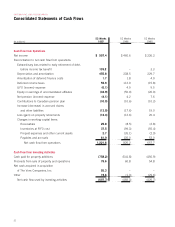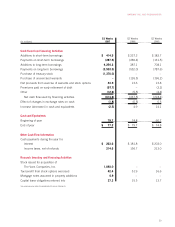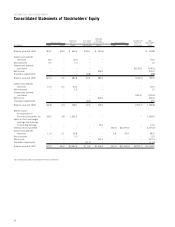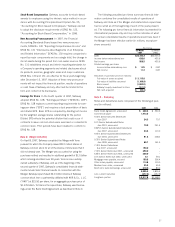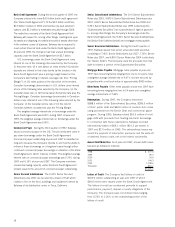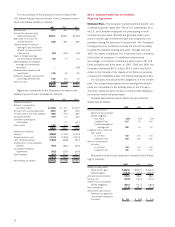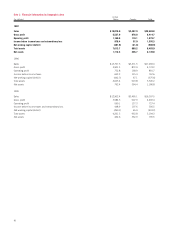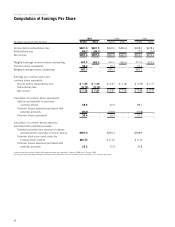Safeway 1997 Annual Report Download - page 31
Download and view the complete annual report
Please find page 31 of the 1997 Safeway annual report below. You can navigate through the pages in the report by either clicking on the pages listed below, or by using the keyword search tool below to find specific information within the annual report.
Bank Credit Agreement During the second quarter of 1997, the
Company entered into a new $3.0 billion bank credit agreement
(the “Bank Credit Agreement”). Of the $3.0 billion credit line,
$2.0 billion matures in 2002 and has two one-year extension
options, and $1.0 billion is renewable annually through 2004.
The restrictive covenants of the Bank Credit Agreement limit
Safeway with respect to, among other things, creating liens upon
its assets and disposing of material amounts of assets other than
in the ordinary course of business. Safeway also is required to
meet certain financial tests under the Bank Credit Agreement.
At year-end 1997, the Company had total unused borrowing
capacity under the Bank Credit Agreement of $2.7 billion.
U.S. borrowings under the Bank Credit Agreement carry
interest at one of the following rates selected by the Company:
(i) the prime rate; (ii) a rate based on rates at which Eurodollar
deposits are offered to first-class banks by the lenders in the
Bank Credit Agreement plus a pricing margin based on the
Company’s debt rating or interest coverage ratio (the “Pricing
Margin”); or (iii) rates quoted at the discretion of the lenders.
Canadian borrowings denominated in U.S. dollars carry interest
at one of the following rates selected by the Company: (a) the
Canadian base rate; or (b) the Canadian Eurodollar rate plus the
Pricing Margin. Canadian borrowings denominated in Canadian
dollars carry interest at one of the following rates selected by the
Company: (i) the Canadian prime rate or (ii) the rate for
Canadian bankers acceptances plus the Pricing Margin.
The weighted average interest rate on borrowings under the
Bank Credit Agreement was 6.00% during 1997. At year-end
1997, the weighted average interest rate on borrowings under the
Bank Credit Agreement was 5.90%.
Commercial Paper During the third quarter of 1997, Safeway
issued commercial paper in the U.S. The proceeds were used to
pay down borrowings under the Bank Credit Agreement.
Commercial paper outstanding at year-end 1997 is classified as
long-term because the Company intends to and has the ability to
refinance these borrowings on a long-term basis through either
continued commercial paper borrowings or utilization of the Bank
Credit Agreement, which matures in 2002. The weighted average
interest rate on commercial paper borrowings was 5.79% during
1997 and 6.15% at year-end 1997. The Company maintains
unused borrowing capacity under the Bank Credit Agreement
at least equal to the amount of commercial paper outstanding.
Senior Secured Indebtedness The 9.30% Senior Secured
Debentures due 2007 are secured by a Deed of Trust which
created a lien on the land, buildings and equipment owned by
Safeway at its distribution center in Tracy, California.
Senior Subordinated Indebtedness The 10% Senior Subordinated
Notes due 2001, 9.875% Senior Subordinated Debentures due
2007, 9.65% Senior Subordinated Debentures due 2004 and
9.35% Senior Subordinated Notes due 1999 (collectively the
“Subordinated Securities”) are subordinated in right of payment
to, among other things, the Company’s borrowings under the
Bank Credit Agreement, the 9.30% Senior Secured Indebtedness,
the Senior Debt (defined below) and mortgage notes payable.
Senior Unsecured Indebtedness During the fourth quarter of
1997, Safeway issued new senior unsecured debt securities
consisting of 7.45% Senior Debentures due 2027, 7.00% Senior
Notes due 2007, and 6.85% Senior Notes due 2004 (collectively,
the “Senior Debt”). The Company used the proceeds from this
debt to redeem a portion of the Subordinated Securities.
Mortgage Notes Payable Mortgage notes payable at year-end
1997 have remaining terms ranging from one to 12 years, have
a weighted average interest rate of 9.97% and are secured by
properties with a net book value of approximately $300 million.
Other Notes Payable Other notes payable at year-end 1997 have
remaining terms ranging from two to 14 years and a weighted
average interest rate of 7.46%.
Redemptions During 1997, the Company redeemed
$588.5 million of the Subordinated Securities, $285.5 million
of Vons’ public debt and $40.0 million of medium-term notes
using proceeds from the Senior Debt and commercial paper
program. During 1995, Safeway retired $53.5 million of mort-
gage debt with proceeds from floating rate bank borrowings.
In connection with these redemptions, Safeway recorded
extraordinary losses of $64.1 million ($0.13 per share) in
1997 and $2.0 million in 1995. The extraordinary losses rep-
resent the payment of redemption premiums and the write-off
of deferred finance costs, net of the related tax benefits.
Annual Debt Maturities As of year-end 1997, annual debt maturi-
ties were as follows (in millions):
1998 $ 277.4
1999 99.3
2000 24.9
2001 144.3
2002 1,738.6
Thereafter 810.7
$3,095.2
Letters of Credit The Company had letters of credit of
$226.9 million outstanding at year-end 1997 of which
$64.0 million were issued under the Bank Credit Agreement.
The letters of credit are maintained primarily to support
performance, payment, deposit or surety obligations of the
Company. The Company pays commitment fees ranging
from 0.25% to 1.00% on the outstanding portion of the
letters of credit.
28






